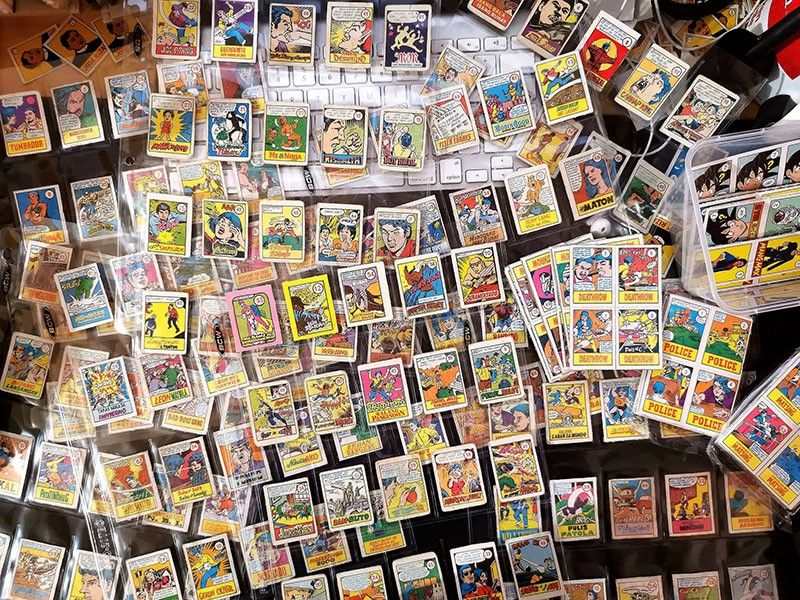
Tsub, tsa, tagilid, akin—are words spoken by a generation of Filipino children at some point in their lives. In that one line, some readers may have already dusted off the old plastic containers which housed these once vibrant pieces of small cards called ‘teks’, a card game played by Pinoy kids.
A once staple of the sari-sari stores conveniently near elementary schools, teks are usually small cards with illustrations depicting different scenes from Pinoy komics, to famous television shows, movies, and even anime (hand-drawn or computer-generated animation style from Japan).
These teks are around a quarter of the size of your typical trading card games, such as Magic: The Gathering, Pokémon, and Yu-Gi-Oh! Back then, it featured short comic strips with dialogues and action scenes often numbered to indicate the series it referenced.
Once billed as a marketing tool for Pinoy komiks in the 1950s, these teks took on a new form during the late ‘90s into the early 2000s when they featured the newest cartoon or anime franchises of the time. Eventually, its designs became predominantly anime-themed with the likes of Dragon Ball Z, Yu Yu Hakusho, and even Pokémon joining the fray.
How to play
The terms at the start refer to how the game was played. Think of it as faces in coins. Three teks or cards will be played: two pamato or the ‘best’ chosen playing card from each player mixed in with the ‘panabla’ or the balance card, so to speak. These three pieces of somewhat small paper will be placed inconveniently into the dealer’s thumb cuticle—mostly the non-partisan friend who flicks the teks into the air. A winner is determined if one pamato lands on a face different from the opponent’s and the panabla.
Some regional rules (or the ‘ganito sa amin’ sentiment) may apply, such as two players simply high-fiving their teks and determining the winner by which card is faced up—but for the most part, Pinoy teks were played with three cards flicked into the air.
Children usually take an especially curated sense of pride in how they display their most precious collection. During this writer’s time, rival teks players tended to show off bundles of their papers in stacks. Usually measured arbitrarily by one hand span or dangkal, clump together in rubber bands.
Before a duel, whether friendly or with stakes, these stacks of teks are often met with a question, ‘Ilang dangkal ‘yan?’ Followed by a show of force by presenting their stash to opponents and onlookers alike, enough to make someone in the area shiver.
Think of it like a Mexican standoff, where players show their weapons—for these kids, their teks and embody aggression through confrontation by belittling each other’s collection. Although often playful, sometimes it gets hurtful. (Clearly this writer is not speaking from experience.) However, much like any cinematic standoff, the energy fizzles out with no clear victories, but just enough build up into playing the actual game.
Choosing your champion, or the pamato is crucial. After all, it’s the only thing you can control once the cards are dealt.
It could be the leading character from an anime, perhaps an unusually designed teks that resembles a specific franchise with enough alterations conveniently evading copyright concerns. Sometimes, it’s just a lucky, old, battered card that balances gravity and luck to always be the odd side flipped to win every scrimmage.
Teks acquired in such battles, whether through wager or conditions set prior are often valued as prized trophies. When a particular player amasses several teks that go beyond the counting cadence of “I-sa, dala-wa, tat-lo, a-pat,” they sometimes even go to another neighborhood or school to play with others.
Origins of trade cards
Teks or trading cards can be traced back as far as late the 1800s to the early 20th century. With the advent of colored lithography, or the printing method of designs drawn into a flat stone, multicolor artwork became more accessible and less expensive to produce.
According to a research piece done by Cornell University, trade cards in color emerged as a viable means of advertising. Over time, what once templated cards wherein traders can just insert the name of their products or services, larger companies started commissioning exclusive artwork for their goods.
From tonics, medicines, cigars, among many others, these trade cards served somewhat as a bonus prize. The colorful artwork and novelty of the designs led to the public in collecting trade cards gaining separate value from a marketing tool to a collectible.
Although not directly related to history of Pinoy teks, the behavior rooted in these Victorian era trade cards are still practiced to this day. Preserving cards that are shiny and bearing vivid imagery resemble pulling rare Pokemon cards from booster packs. The collecting aspect and the subjective value from each owner in completing different sets are all evident to teks and other trading card games past and present.
Do kids still play teks
Although far from classifying teks as one of the definitive traditional games in the Philippines, it can’t be that far off to make an argument that it is still a part of the country’s heritage for a generation of Filipino kids.
With modern-day gadgets such as mobile phones, tablets, and gaming consoles dominating the attention span of the younger generation for recreation, interest in local games such as this continues to wane.
The country has a number of national days to commemorate a particular aspect of culture such as National Children’s Month every November. Originally a piece of legislation under Republic Act No. 10661 of 1989 to safeguard children’s rights, it has since found success in the promotion of the youth’s well-being through community programs such as fun runs, larong Pinoy (Filipino games), and the like.
Celebrations like this could be a platform to reintroduce the younger generation to this once cherished game played by their parents to inspire and expand their horizons in history and appreciation of their local heritage.
It may be a relic of its time or a natural decline to make room for other games, but perhaps there is still value in revitalizing this local hobby.
In South Korea, the concept of ‘newtro’ a portmanteau of new and retro emerged in 2018 that blended modern trends and retro eras of the 1980s and the 1990s. With the right passion and committed people, there’s still a chance for this game to witness the same phenomenon in bringing the old and new together. — Kimani Franco
*****
Credit belongs to: www.philstar.com
 Atin Ito First Filipino Community Newspaper in Ontario
Atin Ito First Filipino Community Newspaper in Ontario






